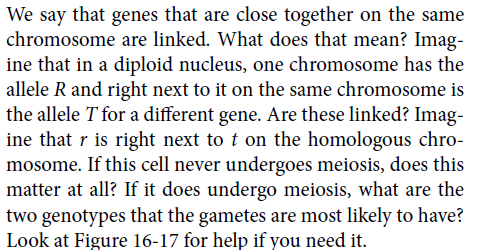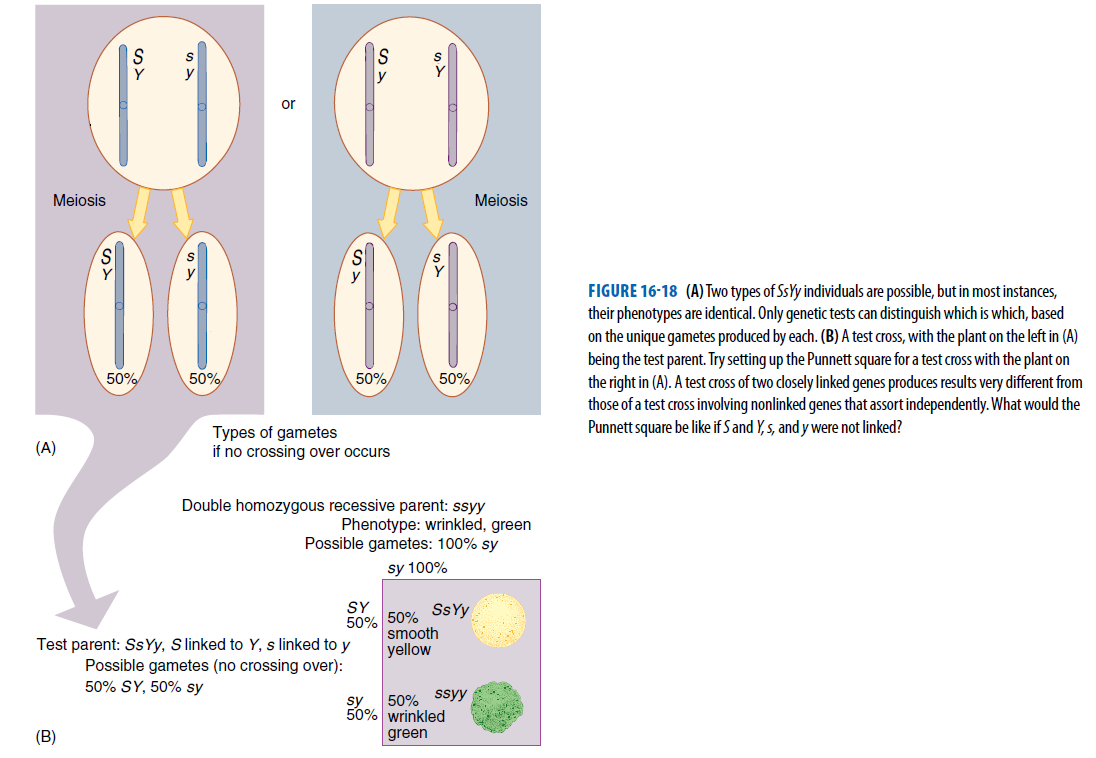We say that genes that are close together on the same chromosome are linked. What does that mean? Imag- ine that in a diploid nucleus, one chromosome has the allele R and right next to it on the same chromosome is the allele T for a different gene. Are these linked? Imag- ine that r is right next to t on the homologous chro- mosome. If this cell never undergoes meiosis, does this matter at all? If it does undergo meiosis, what are the two genotypes that the gametes are most likely to have? Look at Figure 16-17 for help if you need it. Y y Meiosis Meiosis FIGURE 16-18 (A) Two types of SsYy individuals are possible, but in most instances, their phenotypes are identical. Only genetic tests can distinguish which is which, based on the unique gametes produced by each. (B) A test cross, with the plant on the left in (A) being the test parent. Try setting up the Punnett square for a test cross with the plant on the right in (A). A test cross of two closely linked genes produces results very different from those of a test cross involving nonlinked genes that assort independently. What would the Punnett square be like if S and Y, s, and y were not linked? 50% 50% 50%, 50% Types of gametes if no crossing over occurs (A) Double homozygous recessive parent: ssyy Phenotype: wrinkled, green Possible gametes: 100% sy sy 100% 50% 50% Ss Yy smooth SY Test parent: Ss Yy, S linked to Y, s linked to y yellow Possible gametes (no crossing over): 50% SY, 50% sy sy 50% ssyy 50% wrinkled (B) green
We say that genes that are close together on the same chromosome are linked. What does that mean? Imag- ine that in a diploid nucleus, one chromosome has the allele R and right next to it on the same chromosome is the allele T for a different gene. Are these linked? Imag- ine that r is right next to t on the homologous chro- mosome. If this cell never undergoes meiosis, does this matter at all? If it does undergo meiosis, what are the two genotypes that the gametes are most likely to have? Look at Figure 16-17 for help if you need it. Y y Meiosis Meiosis FIGURE 16-18 (A) Two types of SsYy individuals are possible, but in most instances, their phenotypes are identical. Only genetic tests can distinguish which is which, based on the unique gametes produced by each. (B) A test cross, with the plant on the left in (A) being the test parent. Try setting up the Punnett square for a test cross with the plant on the right in (A). A test cross of two closely linked genes produces results very different from those of a test cross involving nonlinked genes that assort independently. What would the Punnett square be like if S and Y, s, and y were not linked? 50% 50% 50%, 50% Types of gametes if no crossing over occurs (A) Double homozygous recessive parent: ssyy Phenotype: wrinkled, green Possible gametes: 100% sy sy 100% 50% 50% Ss Yy smooth SY Test parent: Ss Yy, S linked to Y, s linked to y yellow Possible gametes (no crossing over): 50% SY, 50% sy sy 50% ssyy 50% wrinkled (B) green
Human Heredity: Principles and Issues (MindTap Course List)
11th Edition
ISBN:9781305251052
Author:Michael Cummings
Publisher:Michael Cummings
Chapter3: Transmission Of Genes From Generation To Generation
Section: Chapter Questions
Problem 24QP: Meiosis Explains Mendels Results: Genes Are on Chromosomes The following diagram shows a...
Related questions
Topic Video
Question
The answer to Question 23 will be different if R and T are very far apart on their chromosome (and if that is true, then automatically r and t will also be very far apart on their chromosome). If it undergoes meiosis, there are four genotypes that can be produced, not just two. Why? What are the four genotypes? Which represent recombinant chromosomes? Which represent parental chromosomes? Look at Figure 16-18 for help if you need it.

Transcribed Image Text:We say that genes that are close together on the same
chromosome are linked. What does that mean? Imag-
ine that in a diploid nucleus, one chromosome has the
allele R and right next to it on the same chromosome is
the allele T for a different gene. Are these linked? Imag-
ine that r is right next to t on the homologous chro-
mosome. If this cell never undergoes meiosis, does this
matter at all? If it does undergo meiosis, what are the
two genotypes that the gametes are most likely to have?
Look at Figure 16-17 for help if you need it.

Transcribed Image Text:Y
y
Meiosis
Meiosis
FIGURE 16-18 (A) Two types of SsYy individuals are possible, but in most instances,
their phenotypes are identical. Only genetic tests can distinguish which is which, based
on the unique gametes produced by each. (B) A test cross, with the plant on the left in (A)
being the test parent. Try setting up the Punnett square for a test cross with the plant on
the right in (A). A test cross of two closely linked genes produces results very different from
those of a test cross involving nonlinked genes that assort independently. What would the
Punnett square be like if S and Y, s, and y were not linked?
50%
50%
50%,
50%
Types of gametes
if no crossing over occurs
(A)
Double homozygous recessive parent: ssyy
Phenotype: wrinkled, green
Possible gametes: 100% sy
sy 100%
50% 50% Ss Yy
smooth
SY
Test parent: Ss Yy, S linked to Y, s linked to y
yellow
Possible gametes (no crossing over):
50% SY, 50% sy
sy
50% ssyy
50% wrinkled
(B)
green
Expert Solution
This question has been solved!
Explore an expertly crafted, step-by-step solution for a thorough understanding of key concepts.
Step by step
Solved in 2 steps

Knowledge Booster
Learn more about
Need a deep-dive on the concept behind this application? Look no further. Learn more about this topic, biology and related others by exploring similar questions and additional content below.Recommended textbooks for you

Human Heredity: Principles and Issues (MindTap Co…
Biology
ISBN:
9781305251052
Author:
Michael Cummings
Publisher:
Cengage Learning

Human Heredity: Principles and Issues (MindTap Co…
Biology
ISBN:
9781305251052
Author:
Michael Cummings
Publisher:
Cengage Learning